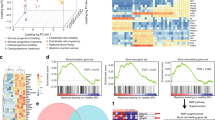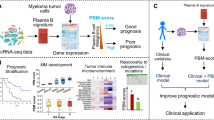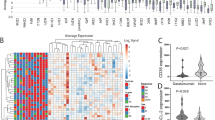Abstract
Pathogenesis of multiple myeloma is associated with an aberrant expression of pro-proliferative, pro-angiogenic and bone-metabolism-modifying factors by malignant plasma cells. Given the frequently long time span from diagnosis of early-stage plasma cell dyscrasias to overt myeloma and the mostly low proliferation rate of malignant plasma cells, we hypothesize these to similarly express a novel class of inhibitory factors of potential prognostic relevance. Bone morphogenic proteins (BMPs) represent possible candidates as they inhibit proliferation, stimulate bone formation and have an effect on the survival of cancer patients. We assessed the expression of BMPs and their receptors by Affymetrix DNA microarrays (n=779) including CD138-purified primary myeloma cell samples (n=635) of previously untreated patients. BMP6 is the only BMP expressed by malignant and normal plasma cells. Its expression is significantly lower in proliferating myeloma cells, myeloma cell lines or plasmablasts. BMP6 significantly inhibits the proliferation of myeloma cell lines, survival of primary myeloma cells and in vitro angiogenesis. A high BMP6 expression in primary myeloma cell samples delineates significantly superior overall survival for patients undergoing high-dose chemotherapy independent of conventional prognostic factors (International Staging System (ISS) stage, β2 microglobulin).
This is a preview of subscription content, access via your institution
Access options
Subscribe to this journal
Receive 50 print issues and online access
$259.00 per year
only $5.18 per issue
Buy this article
- Purchase on Springer Link
- Instant access to full article PDF
Prices may be subject to local taxes which are calculated during checkout







Similar content being viewed by others
References
Barlogie B, Tricot G, Rasmussen E, Anaissie E, van RF, Zangari M et al. (2006). Total therapy 2 without thalidomide in comparison with total therapy 1: role of intensified induction and posttransplantation consolidation therapies. Blood 107: 2633–2638.
Blade J, Samson D, Reece D, Apperley J, Bjorkstrand B, Gahrton G et al. (1998). Criteria for evaluating disease response and progression in patients with multiple myeloma treated by high-dose therapy and haemopoietic stem cell transplantation. Myeloma Subcommittee of the EBMT. European Group for Blood and Marrow Transplant. Br J Haematol 102: 1115–1123.
Caplan AI . (2007). Adult mesenchymal stem cells for tissue engineering versus regenerative medicine. J Cell Physiol 213: 341–347.
Cheng H, Jiang W, Phillips FM, Haydon RC, Peng Y, Zhou L et al. (2003). Osteogenic activity of the fourteen types of human bone morphogenetic proteins (BMPs). J Bone Joint Surg Am 85-A: 1544–1552.
Clement JH, Sanger J, Hoffken K . (1999). Expression of bone morphogenetic protein 6 in normal mammary tissue and breast cancer cell lines and its regulation by epidermal growth factor. Int J Cancer 80: 250–256.
Corre J, Mahtouk K, Attal M, Gadelorge M, Huynh A, Fleury-Cappellesso S et al. (2007). Bone marrow mesenchymal stem cells are abnormal in multiple myeloma. Leukemia 21: 1079–1088.
Cremer FW, Bila J, Buck I, Kartal M, Hose D, Ittrich C et al. (2005). Delineation of distinct subgroups of multiple myeloma and a model for clonal evolution based on interphase cytogenetics. Genes Chromosomes Cancer 44: 194–203.
Dai J, Keller J, Zhang J, Lu Y, Yao Z, Keller ET . (2005). Bone morphogenetic protein-6 promotes osteoblastic prostate cancer bone metastases through a dual mechanism. Cancer Res 65: 8274–8285.
De Vos J, Couderc G, Tarte K, Jourdan M, Requirand G, Delteil MC et al. (2001). Identifying intercellular signaling genes expressed in malignant plasma cells by using complementary DNA arrays. Blood 98: 771–780.
De Vos J, Hose D, Reme T, Tarte K, Moreaux J, Mahtouk K et al. (2006). Microarray-based understanding of normal and malignant plasma cells. Immunol Rev 210: 86–104.
Du J, Yang S, Wang Z, Zhai C, Yuan W, Lei R et al. (2007). Bone morphogenetic protein 6 inhibit stress-induced breast cancer cells apoptosis via both Smad and p38 pathways. J Cell Biochem 103: 1584–1597.
Durie BG . (1986). Staging and kinetics of multiple myeloma. Semin Oncol 13: 300–309.
Ebisawa T, Tada K, Kitajima I, Tojo K, Sampath TK, Kawabata M et al. (1999). Characterization of bone morphogenetic protein-6 signaling pathways in osteoblast differentiation. J Cell Sci 112: 3519–3527.
Goldschmidt H, Sonneveld P, Cremer FW, van der HB, Westveer P, Breitkreutz I et al. (2003). Joint HOVON-50/GMMG-HD3 randomized trial on the effect of thalidomide as part of a high-dose therapy regimen and as maintenance treatment for newly diagnosed myeloma patients. Ann Hematol 82: 654–659.
Greipp PR, San Miguel J, Durie BG, Crowley JJ, Barlogie B, Blade J et al. (2005). International staging system for multiple myeloma. J Clin Oncol 23: 3412–3420.
Hamdy FC, Autzen P, Robinson MC, Horne CH, Neal DE, Robson CN . (1997). Immunolocalization and messenger RNA expression of bone morphogenetic protein-6 in human benign and malignant prostatic tissue. Cancer Res 57: 4427–4431.
Haudenschild DR, Palmer SM, Moseley TA, You Z, Reddi AH . (2004). Bone morphogenetic protein (BMP)-6 signaling and BMP antagonist noggin in prostate cancer. Cancer Res 64: 8276–8284.
Hoang B, Zhu L, Shi Y, Frost P, Yan H, Sharma S et al. (2006). Oncogenic RAS mutations in myeloma cells selectively induce cox-2 expression, which participates in enhanced adhesion to fibronectin and chemoresistance. Blood 107: 4484–4490.
Hose D, Moreaux J, Meissner T, Seckinger A, Goldschmidt H, Benner A et al. (2009a). Induction of angiogenesis by normal and malignant plasma cells. Blood 114: 128–143.
Hose D, Reme T, Meissner T, Moreaux J, Seckinger A, Lewis J et al. (2009b). Inhibition of aurora kinases for tailored risk-adapted treatment of multiple myeloma. Blood 113: 4331–4340.
Irie A, Habuchi H, Kimata K, Sanai Y . (2003). Heparan sulfate is required for bone morphogenetic protein-7 signaling. Biochem Biophys Res Commun 308: 858–865.
Jourdan M, Ferlin M, Legouffe E, Horvathova M, Liautard J, Rossi JF et al. (1998). The myeloma cell antigen syndecan-1 is lost by apoptotic myeloma cells. Br J Haematol 100: 637–646.
Kawabata M, Imamura T, Miyazono K . (1998). Signal transduction by bone morphogenetic proteins. Cytokine Growth Factor Rev 9: 49–61.
Kersten C, Dosen G, Myklebust JH, Sivertsen EA, Hystad ME, Smeland EB et al. (2006). BMP-6 inhibits human bone marrow B lymphopoiesis—upregulation of Id1 and Id3. Exp Hematol 34: 72–81.
Kersten C, Sivertsen EA, Hystad ME, Forfang L, Smeland EB, Myklebust JH . (2005). BMP-6 inhibits growth of mature human B cells; induction of Smad phosphorylation and upregulation of Id1. BMC Immunol 6: 9.
Kim IY, Lee DH, Lee DK, Kim BC, Kim HT, Leach FS et al. (2003). Decreased expression of bone morphogenetic protein (BMP) receptor type II correlates with insensitivity to BMP-6 in human renal cell carcinoma cells. Clin Cancer Res 9: 6046–6051.
Klein B, Tarte K, Jourdan M, Mathouk K, Moreaux J, Jourdan E et al. (2003). Survival and proliferation factors of normal and malignant plasma cells. Int J Hematol 78: 106–113.
Kochanowska I, Chaberek S, Wojtowicz A, Marczynski B, Wlodarski K, Dytko M et al. (2007). Expression of genes for bone morphogenetic proteins BMP-2, BMP-4 and BMP-6 in various parts of the human skeleton. BMC Musculoskelet Disord 8: 128.
Kusu N, Laurikkala J, Imanishi M, Usui H, Konishi M, Miyake A et al. (2003). Sclerostin is a novel secreted osteoclast-derived bone morphogenetic protein antagonist with unique ligand specificity. J Biol Chem 278: 24113–24117.
Kyle RA, Rajkumar SV . (2004). Multiple myeloma. N Engl J Med 351: 1860–1873.
Mahtouk K, Cremer FW, Reme T, Jourdan M, Baudard M, Moreaux J et al. (2006). Heparan sulphate proteoglycans are essential for the myeloma cell growth activity of EGF-family ligands in multiple myeloma. Oncogene 25: 7180–7191.
Mahtouk K, Hose D, Raynaud P, Hundemer M, Jourdan M, Jourdan E et al. (2007). Heparanase influences expression and shedding of syndecan-1, and its expression by the bone marrow environment is a bad prognostic factor in multiple myeloma. Blood 109: 4914–4923.
Mahtouk K, Hose D, Reme T, De Vos J, Jourdan M, Moreaux J et al. (2005). Expression of EGF-family receptors and amphiregulin in multiple myeloma. Amphiregulin is a growth factor for myeloma cells. Oncogene 24: 3512–3524.
Massague J . (2000). How cells read TGF-beta signals. Nat Rev Mol Cell Biol 1: 169–178.
Moreaux J, Cremer FW, Reme T, Raab M, Mahtouk K, Kaukel P et al. (2005). The level of TACI gene expression in myeloma cells is associated with a signature of microenvironment dependence versus a plasmablastic signature. Blood 106: 1021–1030.
Nohe A, Keating E, Knaus P, Petersen NO . (2004). Signal transduction of bone morphogenetic protein receptors. Cell Signal 16: 291–299.
Ren R, Charles PC, Zhang C, Wu Y, Wang H, Patterson C . (2007). Gene expression profiles identify a role for cyclooxygenase 2-dependent prostanoid generation in BMP6-induced angiogenic responses. Blood 109: 2847–2853.
Ro TB, Holt RU, Brenne AT, Hjorth-Hansen H, Waage A, Hjertner O et al. (2004). Bone morphogenetic protein-5, -6 and -7 inhibit growth and induce apoptosis in human myeloma cells. Oncogene 23: 3024–3032.
Tarte K, De Vos J, Thykjaer T, Zhan F, Fiol G, Costes V et al. (2002). Generation of polyclonal plasmablasts from peripheral blood B cells: a normal counterpart of malignant plasmablasts. Blood 100: 1113–1122.
Trojan A, Tinguely M, Vallet S, Seifert B, Jenni B, Zippelius A et al. (2006). Clinical significance of cyclooxygenase-2 (COX-2) in multiple myeloma. Swiss Med Wkly 136: 400–403.
Vacca A, Ribatti D, Roncali L, Ranieri G, Serio G, Silvestris F et al. (1994). Bone marrow angiogenesis and progression in multiple myeloma. Br J Haematol 87: 503–508.
Valdimarsdottir G, Goumans MJ, Rosendahl A, Brugman M, Itoh S, Lebrin F et al. (2002). Stimulation of Id1 expression by bone morphogenetic protein is sufficient and necessary for bone morphogenetic protein-induced activation of endothelial cells. Circulation 106: 2263–2270.
Witzig TE, Timm M, Larson D, Therneau T, Greipp PR . (1999). Measurement of apoptosis and proliferation of bone marrow plasma cells in patients with plasma cell proliferative disorders. Br J Haematol 104: 131–137.
Wutzl A, Brozek W, Lernbass I, Rauner M, Hofbauer G, Schopper C et al. (2006). Bone morphogenetic proteins 5 and 6 stimulate osteoclast generation. J Biomed Mater Res A 77: 75–83.
Zhan F, Hardin J, Kordsmeier B, Bumm K, Zheng M, Tian E et al. (2002). Global gene expression profiling of multiple myeloma, monoclonal gammopathy of undetermined significance, and normal bone marrow plasma cells. Blood 99: 1745–1757.
Zhang XG, Gaillard JP, Robillard N, Lu ZY, Gu ZJ, Jourdan M et al. (1994). Reproducible obtaining of human myeloma cell lines as a model for tumor stem cell study in human multiple myeloma. Blood 83: 3654–3663.
Acknowledgements
We thank Katrin Heimlich, Maria Dörner and Gabriele Hoock for technical assistance. This work was supported in part by grants from the Hopp-Foundation (Germany), the University of Heidelberg (Germany), the National Centre for Tumor Diseases (Heidelberg, Germany), the Tumorzentrum Heidelberg/Mannheim (Germany), the European Myeloma Stem Cell Network (MSCNET) funded within the 6th framework program of the European Community, Novartis Pharma GmbH (Nuremberg, Germany), the Ligue Nationale Contre Le Cancer (équipe labellisée) (Paris, France). It is also part of a national program called ‘Carte d’Identité des Tumeurs' (CIT) funded by the Ligue Nationale Contre le Cancer (France).
Author information
Authors and Affiliations
Corresponding author
Additional information
Supplementary Information accompanies the paper on the Oncogene website (http://www.nature.com/onc)
Supplementary information
Rights and permissions
About this article
Cite this article
Seckinger, A., Meißner, T., Moreaux, J. et al. Bone morphogenic protein 6: a member of a novel class of prognostic factors expressed by normal and malignant plasma cells inhibiting proliferation and angiogenesis. Oncogene 28, 3866–3879 (2009). https://doi.org/10.1038/onc.2009.257
Received:
Revised:
Accepted:
Published:
Issue Date:
DOI: https://doi.org/10.1038/onc.2009.257



